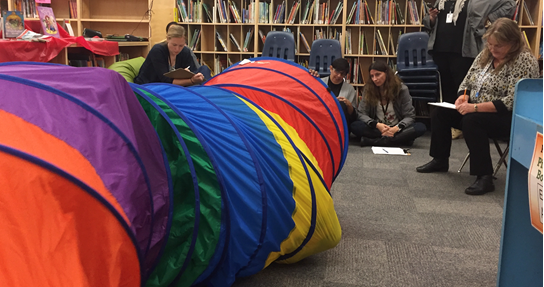Transdisciplinary Play-Based van Dijk Assessment
Transdisciplinary Play-Based van Dijk Assessment (TPBVDA) is a pilot project between PRCVI, the Provincial Outreach Program for Students with Deafblindness (POPDB), and educational teams in the Surrey School District. The development of the TPBVDA process is inspired by the van Dijk approach to the assessment of students with complex developmental profiles including hearing and visual impairment. The van Dijk approach is fundamentally child-guided, assuming competence and intentionality in the learner and allowing the assessment process to unfold in the context of the learner's motivations and interests.
The TPBVDA project asks the question - "How do we know what we know about our students with deafblindness?" For many learners, the educational team has access to various medical and therapy reports - each reporting on a specific aspect of the student's functioning based on observations and testing conducted in a clinical setting. What was missing was a holistic view based on naturalistic observations in a functional environment that is meaningful to the learner. In order to balance these two perspectives - specialist insight and authentic assessment - our team have applied a Transdisciplinary Play-Based Assessment (TPBA) framework with the van Dijk approach setting the domains of the assessment.

The TPBVDA team observes a student at play.
The Shape of the TPBVDA
The team is composed of resource teachers, teachers of students with visual impairments, a teacher of students with hearing impairments, a teacher of students with deafblindness, a deafblind intervenor, orientation and mobility specialists, and a speech-language pathologist. We meet to collaboratively design a series of play scenarios consistent with a TPBA. One team member is nominated as the "play facilitator" and is the only one who interacts with the student while the rest of the team conducts structured observations of play scenarios between the facilitator and the learner:
- Structured facilitation
- Examples: Systematic presentation of musical instruments, exploring a series of objects on a lightbox
- Unstructured facilitation
- Examples: Singing favourite songs and rhymes, exploring found objects using a CCTV.
- Gross Motor Play
- Examples: Delivering an important note to the main office, looking for interesting leaves on the playground.
- Peer interaction
- Examples: Sharing storybooks with a peer, playing inside a tunnel.
Each team member is assigned to observe and record student behaviours within a specific van Dijk assessment domain. The play scenarios are also video recorded. These domains are listed in this article by Nelson and van Dijk.
Following their observations of the play scenarios, the team meets several times to debrief. The video is reviewed and team members discuss their observations through their own professional lenses. These varying perspectives are discussed in detail and the team collaboratively develops a series of transdisciplinary recommendations for educational programming for the learner.
For more information on the TPBVDA pilot project please contact a PRCVI Outreach Coordinator.
Quicklinks
